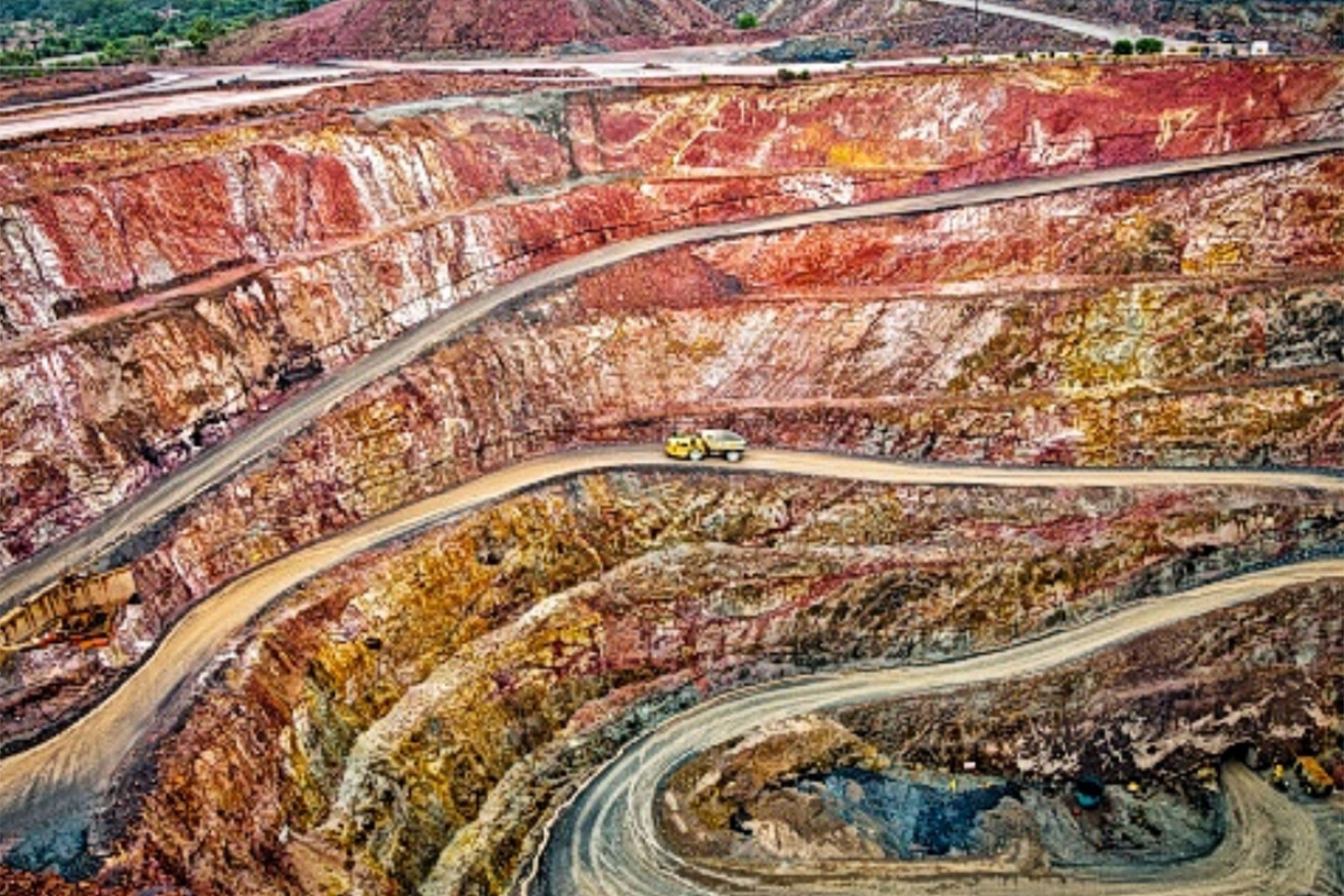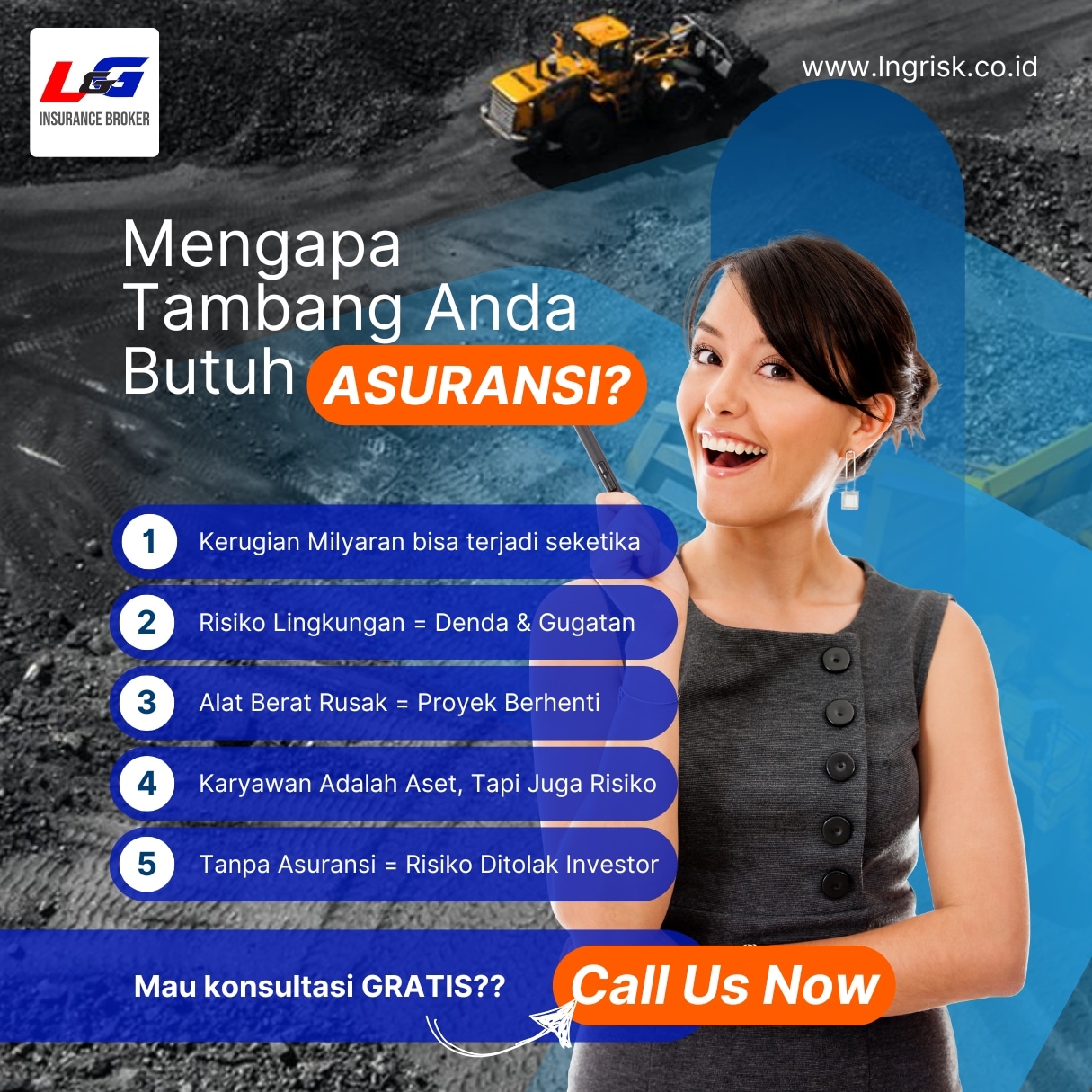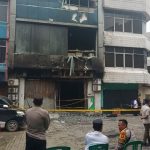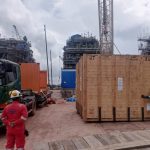Liga Asuransi – Dear readers, how are you? Hope that your business is doing well. After a few weeks of not writing, now I would like to discuss risk management and insurance again.
This time is about risk management and insurance for gold mining operations. As we know, Indonesia is among the 10th largest gold-producing countries in the world. The largest gold reserves in Indonesia are on the island of Papua in eastern Indonesia. However, gold is also found on several other islands.
The following is a list of 7 gold mining companies that have been listed in the capital market:
- PT Aneka Tambang Tbk (ANTM)
- PT Merdeka Copper Gold Tbk
- PT Medco Energi Tbk/PT Amman Mineral Nusa Tenggara (AMNT).
- PT United Tractors Tbk / Martabe Gold Mine in North Sumatra
- PT J Resources Asia Pacific (PSAB) Bolaang Mangondow
- PT Bumi Resources Minerals Tbk (BRMS) Palu and Gorontalo.
- PT Archi Indonesia Tbk (ARCI) Loka Tindung gold mine located in North Sulawesi.
Mining Accidents
For your information, gold mining is considered much more hazardous than hard rock mining due to flat-lying rock strata, generally incompetent rock, methane gas, and gold dust.
A mining accident is an accident that occurs during the process of mining minerals or metals. Thousands of miners die from mining accidents yearly, mainly underground gold mining, although accidents also occur in hard rock mining.
Most of the deaths these days occur in developing and rural parts of developed countries where safety measures are not practiced as fully. A mining disaster is an incident where there are five or more fatalities.
Other than extensive loss planning, risk assessment, management programs, and scenario testing, mining companies must ensure they have the proper insurance to cover any loss. Instances of high-loss incidents are relatively few, but they are significant if they occur, making insurance that covers the entire lifecycle of a project essential.
Today, miners face frontier environments, issues with social licenses to operate, potential impacts of climate change policies and local governments, cost-management challenges, issues around infrastructure access, and softening commodity markets.
Stage of Mining Process
- Exploration
- Development/Transitional
- Production
Mining Exploration Risks
A successful mineral exploration strategy requires identifying some risk sources and considering them in the decision-making process so that controllable risk can be reduced.
Risk is defined as the chance of failure or loss. Exploration is an economic activity involving risk and uncertainty, so risk must be defined in an economic context.
Risk reduction can be addressed in three fundamental ways:
- Increasing the number of examinations.
- Increasing success probabilities, and
- changing success probabilities per test by learning.
Gold mining is the extraction of gold resources by mining. Historically, mining gold from alluvial deposits used manual separation processes, such as gold panning. However, expanding gold mining to ores, not on the surface, has led to more complex extraction processes, such as pit mining and gold cyanidation.
Like all mining, human rights and environmental issues are common in gold mining. Health and safety risks are much higher in smaller mines with less regulation.
Mining Development Risks
A phased approach to mine development, a proven business model for risk reduction
The “phased approach” to mine development is a proven business model for investors to “de-risk” stakeholder investments before committing significant capital to a mining project.
Stakeholders include shareholders, investors, local communities, government institutions, company employees, and management.
The strategy is to explore and build a mine in phases for the last time and upfront investment dollars with subsequent investment based on continued success. Success means responsible project de-risking and demonstrated economic viability, which warrants further investment.
Open Pit Mining
The findings from exploration drilling are then used to develop what we call a resource model. This provides the information we need to work out where to mine.
Waste rock is transported to a waste rock stack, which is rehabilitated or used to stabilize and fill previously mined areas. This breaks up the rock and makes it easier to transport. The ore and waste areas are marked out, and a fleet of excavators and dump trucks mine each site separately. Gold-bearing ore is transported to stockpiles ready for processing.
Underground Mining
Once the mining area is defined, a portal entrance is cut, and surface infrastructure is established (up to six months). A long tunnel called a decline, a return airway, and branching lateral access drives are then developed to reach the ore (two months to several years). Normal lateral ore development and production cycles commence after the main tunnel is established.
Infill drilling is used to further define the position of the orebody at a higher resolution and increase the accuracy and resolution of the geological model, on which the mine design is based.
Grade control drilling and stopping (ore mining) occur along the lateral development drives. This provides material samples used to determine the exact grade and nature of the ore.
A development cycle of drilling, blasting, bogging, and ground support is used to develop the tunnels. Discharge is required to fragment (break up) the rock before excavation (taking the stone out) by low-profile excavators called boggers.
Gold Processing
Stage 1: Crushing and Grinding
Ore stockpiled from underground and open pit mines is fed into the primary crusher at the process plant. The jaws crush the rock to fit through the 125mm gap at the bottom.
Crushed rock, then travels to the mill. As the mill turns, steel balls inside are lifted against the mill walls and fall onto the stone to crush and grind it even further. At the same time, water is pumped in to turn the crushed rock into a slurry.
The slurry is pumped into the primary cyclones (used to size the material). The coarser material falls to the bottom and returns to the crushing/grinding cycle. The lighter material spins up to the top and is pushed onto the next stage.
Stage 2: Flotation and Oxidisation
The flotation unit cells are the first opportunity to separate gold-bearing ore from waste rock. The primary material is sulfide ore (containing gold particles).
SIBX (Sodium Isobutyl Xanthate) is pumped into the slurry and causes the gold particles to bond with the sulfur inside the rock. Air is used to agitate the slurry and float the gold-bonded sulfur over the top of the tanks onto the next stage.
This process is repeated to concentrate the gold-bearing ore and separate it from the waste rock (increasing the grade of the ore).
Stage 3: Leaching and Adsorption
The oxidized slurry travels to the carbon leach circuit to dissolve the gold out of the rock. It travels through a series of gravity-fed tanks filled with sodium cyanide, with higher concentrations at first and weaker at the end of the line. The sodium cyanide leaches the gold from the rocks turning it into a liquid. A gravel particle can take three to four days to travel through the tanks.
When the rock particle reaches the last tank, 98.5% of the gold is recovered. At the same time, activated carbon (coconut husks) is pumped upstream through the tank system to catch the leached liquid gold. Once full of gold, the carbon travels to a gold desorption column designed to wash the gold out of the carbon. When this process is complete, eluate contains hot water, gold solution, cyanide, and caustic soda. The eluate is transported to the gold room and electroplated onto cathodes wrapped in steel wool.
Rehabilitation & Closure
Mine rehabilitation and closure complete the mining cycle. Mining is only a temporary land use and the community (i.e. the local farming community, has expectations on how the mine will be closed and the land handed on for future land use is a key driver for decision-making in mine closure and rehabilitation.
As such, closure and rehabilitation are integral aspects of the mine design process. By including elements for closure and rehabilitation early in the mine design process, significant environmental impacts can be avoided, such as backfilling of mined open pits instead of creating new waste rock stacks and thereby limiting the environmental footprint of the mine.
Risk and Insurance Management for gold mining:
Risk assessments, risk engineering, risk management, and training and support in risk-related areas.
Insurance market relationships with the most relevant underwriters in Indonesia and international markets to create the right insurance program at competitive prices.
A unique mining construction insurance facility, renewable annually or bi-annually with the same market and able to capture additional projects to maximize leverage across a whole project portfolio.
The policy covers your main assets, such as plant, surface, and underground equipment.
Such equipment may include your CIL/CIP plant (CIP: cyanidation carbon in pulp method CIL: cyanidation carbon in slurry method) hoist houses and equipment, surface and underground drill rigs/jackhammers, compressors, pipes, tracks, and ventilation, as well as buildings and residential accommodation.
Bullion – Covers diamonds, precious stones, and metals, the final gold product, gold bullion, from the Elution and smelting plant to delivery at Fidelity.
The impact of natural catastrophe events on mining – operators with mines in high-risk areas prone to earthquakes, storms, and hurricanes that occurred last year, for example, are likely to face higher scrutiny from insurers throughout this year.
The nature of modern mining operations means that companies typically face some of the most remote and inhospitable locations in the world, making them far more susceptible to risk.
That risk can extend from the sheer difficulty of operating a stretched and disparate supply chain or the distance from urban centers, and thus medical aid and so forth, through to dangers such as political instability or the risk of kidnap.
The increased use of advanced technology in mining operations has seen insurers place considerable emphasis on risks associated with cybersecurity of late.
This is prudent considering the increased use of network systems, particularly in remote operations, and techniques used to monitor technology, handling operations, and processing facilities.
While all the risks can inevitably cause disruption to operations if they come to fruition, insurers offer specific business interruption policies to mining operators.
These form a key component of a company’s business continuity plan and are specifically designed to compensate for any financial impact caused by the interruption or interference to business that results from damage to insured property.
Simply put, they exist to return the business to the financial position it would be in had the incident not occurred.
Gold Mining Insurance
For a good reason, mining insurance is a specialist area of cover protecting businesses, property, employees, equipment, and contractors from a myriad of potential risks.
Typically, specialist mining insurance providers offer a broad range of services that can cover such things as property and business interruption, damage to plant and machinery, innovative new technology such as drones and remote equipment, global life and accident insurance, and special high-risk coverage policies.
International standard insurance coverages for the mining industry
- Cargo
- Construction & Environmental Impairment Liability
- Directors & Officers Liability
- Global Life and Personal Accident insurance, Emergency Medical Evacuation insurance, Kidnapping insurance, and other specialists’ high-risk coverage.
- International Liability insurance – protects your business from third-party claims and can include cover for your key people and business reputation.
- Personal Accident, Health & Travel
- Plant and Machinery insurance covers damage or total loss, including malicious attacks, sabotage, war, and terrorism.
- Property and Business Interruption cover for companies, operators, and contractors involved in the mining industry
- Specie & Bullion
- Trade and Political Risk insurance to protect overseas operations in unstable regions
How to arrange gold mining insurance in Indonesia
As explained above, the gold mining industry is considered a high risks business; therefore, only a few insurance companies are interested in covering this industry.
To find a high-quality insurance program for your gold mining plant, you need to work with an experienced insurance broker.
An insurance broker is an insurance expert that can design a comprehensive insurance program that meets your business profile. The broker will deal with reputable and robust insurance companies locally and overseas to negotiate maximum coverage and efficient insurance premium.
One of the leading insurance brokers in Indonesia is L&G Insurance Broker.
For all your insurance needs, please call L&G Now!
- https://miningdigital.com/supply-chain-and-operations/managing-risk-mining-sector-through-specialist-insurance
- https://miningdigital.com/top10/top-10-risks-for-the-mining-industry
- https://en.wikipedia.org/wiki/Mining_accident
- https://oceanagold.com/operation/macraes/the-mining-process/
—
LOOKING FOR INSURANCE PRODUCTS? DON’T WASTE YOUR TIME AND CONTACT US RIGHT NOW
L&G HOTLINE 24 HOURS: 0811-8507-773 (CALL – WHATSAPP – SMS)
website: lngrisk.co.id
E-mail: customer.support@lngrisk.co.id
—







![[RECAP WEBINAR: Heavy Eqipment, Heavy Risk]
Dalam industri konstruksi dan pertambangan, alat berat bekerja di lingkungan penuh risiko. Mulai dari perpindahan antar lokasi, operasi di medan ekstrem, hingga potensi kecelakaan dan kerusakan mekanis. Tanpa perlindungan yang tepat, kerugian yang muncul bisa mencapai ratusan juta hingga miliaran rupiah.
Webinar ini membahas secara mendalam:
✅ Risiko utama yang mengancam alat berat di proyek konstruksi & tambang
✅ Jenis perlindungan penting seperti CPM (Contractor’s Plant & Machinery) dan Equipment All Risks
✅ Klausul yang sering terlewat oleh pemilik alat dan perusahaan rental
✅ Peran krusial broker asuransi dalam memastikan penutupan polis tepat dan klaim berjalan mulus
Dengan jaminan asuransi alat berat yang sesuai, operasional proyek Anda tetap aman, efisien, dan terlindungi dari kerugian besar.
📣 Nantikan webinar edukatif berikutnya dari L&G Insurance Broker untuk memperluas wawasan Anda tentang manajemen risiko di industri konstruksi dan alat berat! Follow akun kami dan aktifkan notifikasi agar tidak ketinggalan😉
#webinargratis #onlinewebinar #webinar #AsuransiAlatBerat #HeavyEquipment #CPMInsurance #MiningSafety #BrokerAsuransi #AmanBersamaLNG](https://scontent-yyz1-1.cdninstagram.com/v/t51.82787-15/583486524_18408253015184229_1382819462085136671_n.jpg?stp=dst-jpg_e35_tt6&_nc_cat=105&ccb=7-5&_nc_sid=18de74&efg=eyJlZmdfdGFnIjoiQ0FST1VTRUxfSVRFTS5iZXN0X2ltYWdlX3VybGdlbi5DMyJ9&_nc_ohc=LEFLS1E6-n4Q7kNvwGkDmyY&_nc_oc=AdnNy0zp0yC2tU0WPBFouFKVjuKRuwBFqR0UNGy6wHFxS6WpLLLJGtM4B1Fzr8Mrd17mFA0DjZunYhLtsFuHsij8&_nc_zt=23&_nc_ht=scontent-yyz1-1.cdninstagram.com&edm=ANo9K5cEAAAA&_nc_gid=oSeaLBWaR-XQBec5hvxCrg&oh=00_Afkx-0gMbHtcHjqh0tCatfkjYDi6lnE953VfIoObFA0qhQ&oe=69458CEF)
![[HADIRI WEBINAR GRATIS]
L&G Academy Online Webinar: Heavy Equipment, Heavy Risk! Wajibnya Perlindungan Asuransi Alat Berat bagi Kontraktor dan Pemilik Alat
Dalam proyek konstruksi dan pertambangan, alat berat adalah aset bernilai tinggi yang menjadi tulang punggung operasional. Namun, kerusakan, kecelakaan, atau kehilangan alat di lapangan bisa menimbulkan kerugian besar dan menghentikan pekerjaan di tengah jalan.
Banyak kontraktor dan pemilik alat baru sadar pentingnya asuransi setelah kerugian terjadi. Padahal, perlindungan yang tepat bisa menjadi penyelamat bisnis.
🎙️ Narasumber:
Mhd. Taufik Arifin
CEO & Founder L&G Insurance Brokers
Lebih dari 40 tahun pengalaman menangani asuransi alat berat, marine, dan proyek besar di Indonesia
📅 Rabu, 12 November 2025
🕙 10.00 WIB – selesai
📍 Live via Zoom
💰 GRATIS! Kuota terbatas
🔗 Registrasi di: bit.ly/3JuYYfh
📲 Daftar sekarang sebelum Anda menyesal jadi salah satu yang “baru sadar setelah rugi besar.”
📞 0811-8507-773
#webinargratis #webinaralatberat #onlinewebinar #kelaswebinargratis #mining #miningequipment #heavyequipment #alatberat #heavyequipmentinsurance #CPM](https://scontent-yyz1-1.cdninstagram.com/v/t51.82787-15/572482319_18404442202184229_2761295381299065355_n.jpg?stp=dst-jpg_e35_tt6&_nc_cat=110&ccb=7-5&_nc_sid=18de74&efg=eyJlZmdfdGFnIjoiRkVFRC5iZXN0X2ltYWdlX3VybGdlbi5DMyJ9&_nc_ohc=YBfuRTABJ5wQ7kNvwEW7q4b&_nc_oc=Adkvywr5WKX6XNcVupQZSVipyaZqfSkpP0dNa7mntKR8bncwCn3olM6crU_KE5LbWJpJpmFdBkCbEoW954Tt7cVM&_nc_zt=23&_nc_ht=scontent-yyz1-1.cdninstagram.com&edm=ANo9K5cEAAAA&_nc_gid=oSeaLBWaR-XQBec5hvxCrg&oh=00_AfmiY4iIbjZ5sEt0hfrf_22YP5cfD6B2RXuaavJfW9Hw9g&oe=694586FF)










